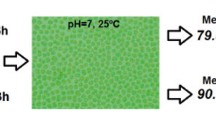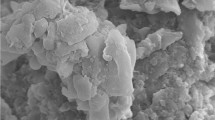Abstract
In this study, the bioaccumulation and biosorption of aqueous metals (cadmium, copper, lead, zinc and trivalent chromium) by live and dead cells of Penicillium simplicissimum (isolate 10) were investigated and compared. Removal experiments under varying cell concentrations, pH and initial metal concentrations revealed that live cells generally achieved highest metal removal rates when 0.80 g fresh weight of cells was used, with metal solutions at pH 5 and concentrations of 50–100 mg L−1 (up to 150 and 200 mg L−1 for cadmium and lead, respectively). On the contrary, biosorption of metals by dead cells occurred at maximum rates when as little as 0.15 g dry weight of cells was used, in conditions of pH 5–7 (metal dependent) and lower metal concentration of 50 mg L−1. This comparative analysis suggested that although effective bioremediation by live cells required more cell biomass and preferred the five metals at concentrations of 50–100 mg L−1, the amount of metals removed by live cells were significantly higher (36.2–86.4% for 100 mg L−1 and pH 5) than by dead cells (8.5–58.9%). The results indicated that bioaccumulation is a favourable process that aids in metal removal together with biosorption, and is presumably more effective than the independent process of biosorption alone (by dead cells). Hence, the metal removal potential of P. simplicissimum, especially live cells of this indoor metal-tolerant isolate, may be applied to wastewaters for effective removal within optimum pH range and metal concentrations.
Graphic Abstract

Article Highlights
-
First few studies to optimize bioaccumulation conditions for P. simplicissimum.
-
Bioaccumulation process was found to be more effective than biosorption.
-
Bioaccumulation allowed metal removal in solutions with high concentrations.
-
Metal biosorption was also optimized but was inferior to bioaccumulation.




Similar content being viewed by others
References
Açıkel Ü, Alp T (2009) A study on the inhibition kinetics of bioaccumulation of Cu(II) and Ni(II) ions using Rhizopus delemar. J Hazard Mater 168:1449–1458. https://doi.org/10.1016/j.jhazmat.2009.03.040
Ali EH, Hashem M (2007) Removal efficiency of the heavy metals Zn(II), Pb(II) and Cd(II) by Saprolegnia delica and Trichoderma viride at different pH values and temperature degrees. Mycobiology 35:135–144. https://doi.org/10.4489/myco.2007.35.3.135
Anahid S, Yaghmaei S, Ghobadinejad Z (2011) Heavy metal tolerance of fungi. Sci Iran 18:502–508. https://doi.org/10.1016/j.scient.2011.05.015
Aytar P, Gedikli S, Buruk Y, Cabuk A, Burnak N (2014) Lead and nickel biosorption with a fungal biomass isolated from metal mine drainage: Box-Behnken experimental design. Int J Environ Sci Technol 11:1631–1640. https://doi.org/10.1007/s13762-013-0354-5
Carolin CF, Kumar PS, Saravanan A, Joshiba GJ, Naushad M (2017) Efficient techniques for the removal of toxic heavy metals from aquatic environment: a review. J Environ Chem Eng 5:2782–2799. https://doi.org/10.1016/j.jece.2017.05.029
Chaudhry MT, Zohaib M, Rauf N, Tahir SS, Parvez S (2014) Biosorption characteristics of Aspergillus fumigatus for the decolorization of triphenylmethane dye acid violet 49. Appl Microbiol Biotechnol 98:3133–3141. https://doi.org/10.1007/s00253-013-5306-y
Chen SH, Ng SL, Cheow YL, Ting ASY (2017) A novel study based on adaptive metal tolerance behavior in fungi and SEM-EDX analysis. J Hazard Mater 334:132–141. https://doi.org/10.1016/j.jhazmat.2017.04.004
Chen SH, Ting ASY (2015) Biosorption and biodegradation potential of triphenylmethane dyes by newly discovered Penicillium simplicissimum isolated from indoor wastewater sample. Int Biodeterior Biodegradation 103:1–7. https://doi.org/10.1016/j.ibiod.2015.04.004
Chew SY, Ting ASY (2016) Common filamentous Trichoderma asperellum for effective removal of triphenylmethane dyes. Desalin Water Treat 57:13534–13539. https://doi.org/10.1080/19443994.2015.1060173
Dursun AY, Uslu G, TepeCuci̇ OY, Eki̇z H (2003) A comparative investigation on the bioaccumulation of heavy metal ions by growing Rhizopus arrhizus and Aspergillus niger. Biochem Eng J 15:87–92. https://doi.org/10.1016/S1369-703X(02)00187-0
Esmaeili A, Mesdaghinia A, Vazirinejad R (2005) Chromium (III) removal and recovery from tannery wastewater by precipitation process. Am J Appl Sci 2:1471–1473. https://doi.org/10.3844/ajassp.2005.1471.1473
Ezzhouri L, Ruiz E, Castro E, Moya M, Espinola F, Cherrat L, Er-Raioui H, Lairini K (2010) Mechanisms of lead uptake by fungal biomass isolated from heavy metals habitats. Afinidad 67:39–44
Fan T, Liu Y, Feng B, Zeng G, Yang C, Zhou M, Zhou H, Tan Z, Wang X (2008) Biosorption of cadmium(II), zinc(II) and lead(II) by Penicillium simplicissimum: Isotherms, kinetics and thermodynamics. J Hazard Mater 160:655–661. https://doi.org/10.1016/j.jhazmat.2008.03.038
Iram S, Shabbir R, Zafar H, Javaid M (2015) Biosorption and bioaccumulation of copper and lead by heavy metal-resistant fungal isolates. Arab J Sci Eng 40:1867–1873. https://doi.org/10.1007/s13369-015-1702-1
Iskandar NL, Zainudin NAIM, Tan SG (2011) Tolerance and biosorption of copper (Cu) and lead (Pb) by filamentous fungi isolated from a freshwater ecosystem. J Environ Sci 23:824–830. https://doi.org/10.1016/s1001-0742(10)60475-5
Kahraman S, Asma D, Erdemoglu S, Yesilada O (2005) Biosorption of copper(II) by live and dried biomass of the white rot fungi Phanerochaete chrysosporium and Funalia trogii. Eng Life Sci 5:72–77. https://doi.org/10.1002/elsc.200420057
Kiran MG, Pakshirajan K, Das G (2017) Heavy metal removal from multicomponent system by sulfate reducing bacteria: mechanism and cell surface characterization. J Hazard Mater 324:62–70. https://doi.org/10.1016/j.jhazmat.2015.12.042
Maliszewska I, Juraszek A, Bielska K (2014) Green synthesis and characterization of silver nanoparticles using Ascomycota fungi Penicillium nalgiovense AJ12. J Clust Sci 25:989–1004. https://doi.org/10.1007/s10876-013-0683-z
Mohammadian Fazli M, Soleimani N, Mehrasbi M, Darabian S, Mohammadi J, Ramazani A (2015) Highly cadmium tolerant fungi: their tolerance and removal potential. J Environ Health Sci Eng 13:19. https://doi.org/10.1186/s40201-015-0176-0
Olivera S, Chaitra K, Venkatesh K, Muralidhara HB, Inamuddin AAM, Ahamed MI (2018) Cerium dioxide and composites for the removal of toxic metal ions. Environ Chem Lett 16:1233–1246. https://doi.org/10.1007/s10311-018-0747-2
Pan R, Cao L, Zhang R (2009) Combined effects of Cu, Cd, Pb, and Zn on the growth and uptake of consortium of Cu-resistant Penicillium sp. A1 and Cd-resistant Fusarium sp. A19. J Hazard Mater 171:761–766. https://doi.org/10.1016/j.jhazmat.2009.06.080
Rafi S, Shoaib A, Awan ZA, Rizvi NB, Nafisa SM (2017) Chromium tolerance, oxidative stress response, morphological characteristics, and FTIR studies of phytopathogenic fungus Sclerotium rolfsii. Folia Microbiol (Praha) 62:207–219. https://doi.org/10.1007/s12223-016-0489-0
Rhee YJ, Hillier S, Gadd GM (2016) A new lead hydroxycarbonate produced during transformation of lead metal by the soil fungus Paecilomyces javanicus. Geomicrobiol J 33:250–260. https://doi.org/10.1080/01490451.2015.1076544
Sharma B, Singh S, Siddiqi NJ (2014) Biomedical implications of heavy metals induced imbalances in redox systems. Biomed Res Int 2014:640754. https://doi.org/10.1155/2014/640754
Sharma S, Adholeya A (2011) Detoxification and accumulation of chromium from tannery effluent and spent chrome effluent by Paecilomyces lilacinus fungi. Int Biodeterior Biodegrad 65:309–317. https://doi.org/10.1016/j.ibiod.2010.12.003
Shoaib A, Aslam N, Athar MM, Akhtar S, Nafisa A, Khurshid S (2013) Removal of Cr(III) through bread mold fungus Pol J Environ Stud 22:1171–1176
Sulaymon AH, Mohammed AA, Al-Musawi TJ (2013) Competitive biosorption of lead, cadmium, copper, and arsenic ions using algae. Environ Sci Pollut Res Int 20:3011–3023. https://doi.org/10.1007/s11356-012-1208-2
Tan WS, Ting ASY (2014) Kinetic and equilibrium modelling on copper(II) removal by live and dead cells of Trichoderma asperellum and the impact of pre-treatments on biosorption. Sep Sci Technol 49:2025–2030. https://doi.org/10.1080/01496395.2014.907808
Taştan BE, Ertuğrul S, Dönmez G (2010) Effective bioremoval of reactive dye and heavy metals by Aspergillus versicolor. Bioresour Technol 101:870–876. https://doi.org/10.1016/j.biortech.2009.08.099
Ting ASY, Lim SJ, Tan WS (2011) Diversity and metal tolerance of filamentous fungi from analytical wastewater in laboratory. In International Congress of the Malaysian Society for Microbiology. Penang, Malaysia, pp 110–113
Valix M, Loon LO (2003) Adaptive tolerance behaviour of fungi in heavy metals. Miner Eng 16:193–198. https://doi.org/10.1016/s0892-6875(03)00004-9
Velmurugan P, Shim J, You Y, Choi S, Kamala-Kannan S, Lee KJ, Kim HJ, Oh BT (2010) Removal of zinc by live, dead, and dried biomass of Fusarium spp. isolated from the abandoned-metal mine in South Korea and its perspective of producing nanocrystals. J Hazard Mater 182:317–324. https://doi.org/10.1016/j.jhazmat.2010.06.032
Wu S, Zhang X, Sun Y, Wu Z, Li T, Hu Y, Su D, Lv J, Li G, Zhang Z, Zheng L, Zhang J, Chen B (2015) Transformation and immobilization of chromium by arbuscular mycorrhizal fungi as revealed by SEM-EDS, TEM-EDS, and XAFS. Environ Sci Technol 49:14036–14047. https://doi.org/10.1021/acs.est.5b03659
Xu X, Xia L, Huang Q, Gu JD, Chen W (2012) Biosorption of cadmium by a metal-resistant filamentous fungus isolated from chicken manure compost. Environ Technol 33:1661–1670. https://doi.org/10.1080/09593330.2011.641591
Acknowledgements
This work was supported by the Malaysian Ministry of Higher Education (FRGS/2/2013/STWN01/MUSM/02/2) and Monash University Malaysia.
Author information
Authors and Affiliations
Corresponding author
Ethics declarations
Conflict of interest
The authors declare that they have no conflict of interest.
Rights and permissions
About this article
Cite this article
Chen, S.H., Cheow, Y.L., Ng, S.L. et al. Bioaccumulation and Biosorption Activities of Indoor Metal-Tolerant Penicillium simplicissimum for Removal of Toxic Metals. Int J Environ Res 14, 235–242 (2020). https://doi.org/10.1007/s41742-020-00253-6
Received:
Revised:
Accepted:
Published:
Issue Date:
DOI: https://doi.org/10.1007/s41742-020-00253-6




